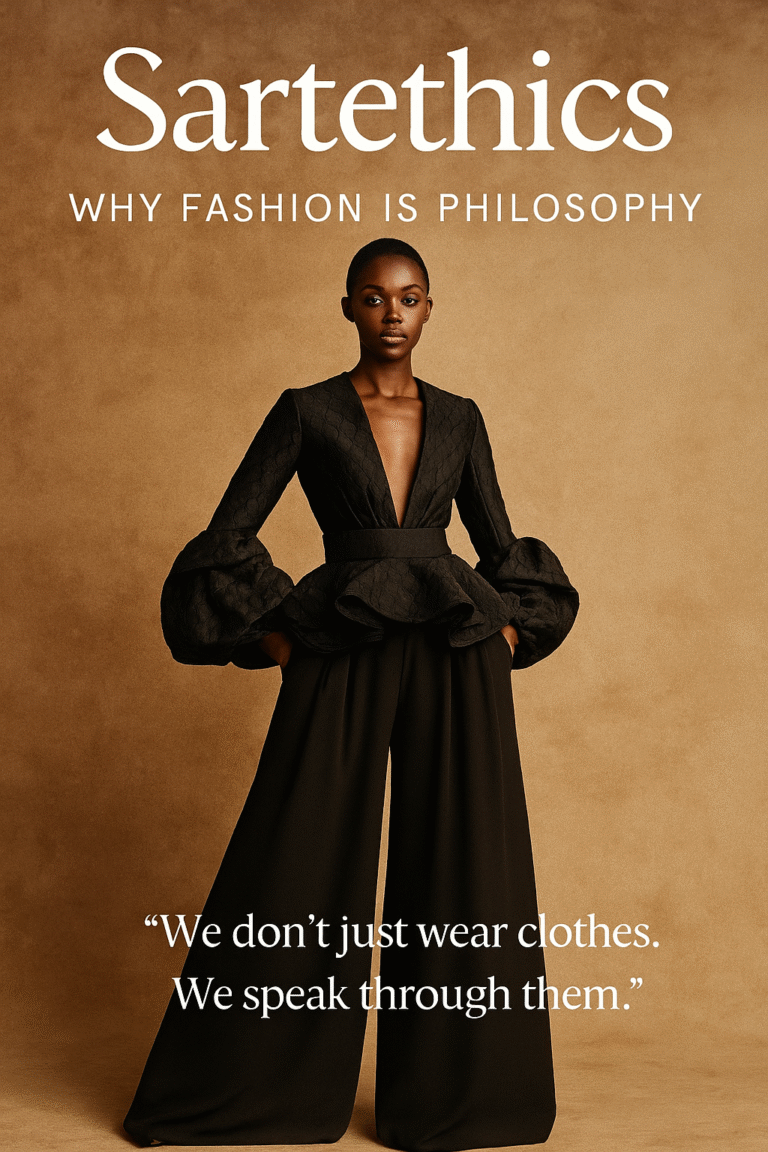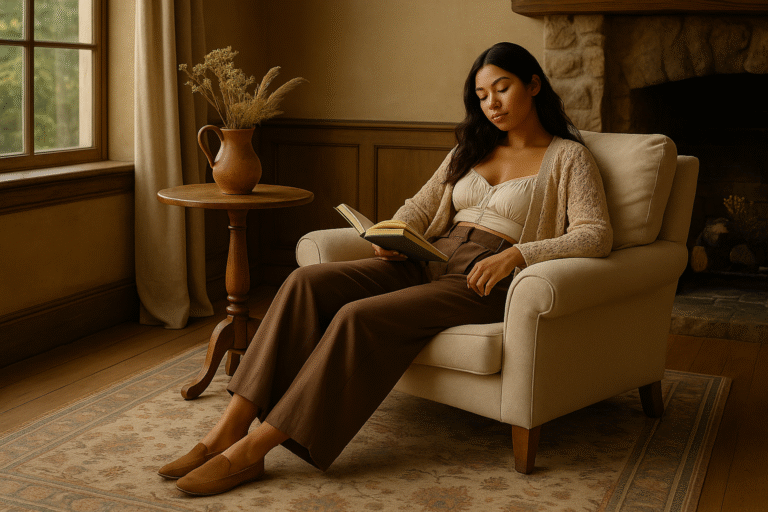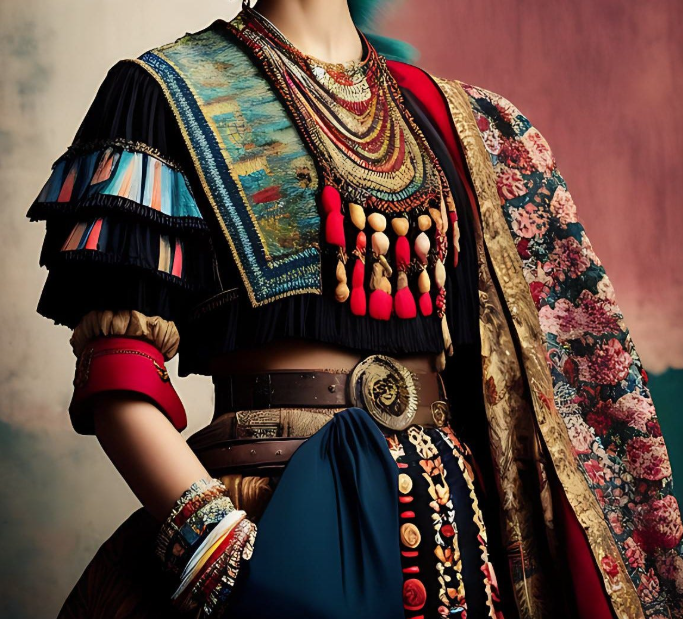Sartethics | Archive: Personal Authenticity: Tailoring a Timeless Wardrobe –2023 Original Article
Fashion trends might come and go, but personal style endures. As we embrace the tenets of Sartethics, an ethical and philosophical approach to fashion, the call to create a timeless wardrobe resonates even more. So, how do we weave the threads of sustainability, authenticity, and personal style into a future-proof wardrobe? Let’s step back to rediscover some practical, eco-friendly habits our forebears practiced.

1. Foundations of Sustainable Wardrobe Wisdom
Before we even begin selecting clothes, we need to understand how garments are made, what they’re made from, and why that matters. These foundational skills build our discernment and deepen our appreciation for every piece we own.
- Understanding Clothing Construction
The first step to curating a sustainable wardrobe lies in comprehending the craftsmanship that goes into every piece of clothing. Dive deeper into how clothes are constructed. Understanding the nuances of stitching, the quality of fabric, and the finish of a garment can significantly influence your buying choices. - Fabric Selection
There was a keen understanding of fabrics and their properties in the past. People chose fabrics not only for their comfort and aesthetics but also for their durability and ease of maintenance. Take a leaf from their book and select clothes made from natural, breathable, and long-lasting fabrics such as cotton, linen, and wool. - Value of Clothing & Respect for Craftsmanship
Appreciation and respect for craftsmanship and artisan work were common in the past. This respect often translated into care for the garment and a desire to maintain and preserve the item due to its perceived value. Clothing was valued, appreciated, and taken care of. The concept of “disposable fashion” was foreign. When you understand your clothing and consider it valuable, you’re more likely to take better care of it, resulting in a longer lifespan. - Investment in Staples
In the past, clothing was considered a significant investment, and people prioritized quality over quantity. Items were carefully selected for their durability, and the intention was to make them last for years or even decades. These staple pieces or “uniforms” would always be in style and could form the basis of many different outfits.
2. Designing for Longevity & Fit
Clothing used to evolve with our bodies and needs. These time-honored techniques remind us that we’re allowed to grow, shift, and adjust—without discarding what we already own.
- Making Garments With Larger Seam Allowances & Hems
Historically, clothing items were often made with generous seam allowances and hems, allowing for alterations. As body sizes changed or styles evolved, clothes could be let out or taken in, ensuring their longevity. Moving towards a more sustainable future, larger seams could become a practical solution for fluctuating body sizes and style adaptations. - Tailoring and Custom-Made Clothes
Before the era of mass-produced clothing, having tailor-made clothes was quite common. Tailoring is just as relevant today. It offers a solution to ill-fitting, off-the-rack clothes in landfills. Custom-made garments ensure a perfect fit and enhance the garment’s longevity, which can easily be adjusted as needed. - DIY and Homemade Fashion
Many people used to make their own clothes, which ensured a perfect fit and meant the garments could be adjusted and updated as needed. Revive the tradition of homemade fashion. By creating your own clothes, you control the materials, ensuring quality, longevity, and a perfect fit. Plus, homemade clothes can be continually updated as per your evolving style.
3. The Art of Wardrobe Curation
When you focus on timeless, versatile garments, your wardrobe becomes a toolkit for everyday life—not a cluttered collection of fleeting trends.
- Choosing Classic Styles Over Trends
Trends are transient; classics are eternal. Choosing timeless styles over fast-changing fashion trends reduces waste and ensures your wardrobe pieces stand the test of time. Think little black dresses, tailored trousers, or a crisp white shirt – classics that never go out of style. - Wardrobe Curation, Versatility, and Timelessness
The key to a sustainable and future-proof wardrobe is versatility. Historically, wardrobes were curated with versatile pieces that could be worn for different occasions and across seasons. The emphasis was on timelessness rather than trends. Opt for garments seamlessly transitioning from a casual brunch to an evening soiree or a business meeting. This flexibility reduces the need for a vast wardrobe and promotes mindful consumption. A well-cut blazer, for example, could be paired with jeans for a casual look, trousers for a formal setting, or over a dress for an evening out. It’s all about getting creative with your wardrobe. - Functional Fashion
In the past, clothing often had a functional purpose beyond just aesthetics. Items were chosen based on utility, meaning they had a longer lifespan because their value wasn’t tied to fleeting fashion trends. - Capsule Wardrobes
While the term might be modern, having a small collection of useful, versatile clothing items is not. This idea promotes mindful purchasing and curating a collection of pieces that work well together. It’s an eco-friendly approach to fashion that aligns perfectly with the tenets of Sartethics. - Layering
People had fewer clothes, but they mastered the art of layering. They often wore the same basic garments year-round and added or removed layers to adapt to weather conditions. Embrace layering. It allows you to adjust your outfits to varying weather conditions without needing a vast collection of seasonal clothes.
4. Caring as an Act of Resistance
Taking care of our clothes is an act of reverence—and rebellion. It slows down the consumption cycle and strengthens our relationship to what we wear.
- Learning Essential Skills
Skills such as sewing, knitting, and darning were more widespread. Empower yourself with skills like sewing, knitting, and darning. These allow you to care for and repair your clothes, significantly extending their lifespan and reducing the need for replacement. - Proper Maintenance
Understanding how to properly care for different fabrics and garments (handwashing delicate items, using the right temperature and cycle on a washing machine, air-drying instead of a dryer, etc.) was common knowledge, which preserved the clothing for longer. Learn the best practices to maintain different fabrics and follow them rigorously. Proper care can significantly reduce wear and tear, ensuring your clothes look great for years. - Regular Maintenance and Repair
In addition to proper washing and storage, conduct regular checks for minor repairs. Promptly fixing small tears or loose buttons can prevent further damage, extending the life of your clothes. - Mending and Repairing
The art of mending and repairing was commonly practiced. From darning socks to patching up jeans, people fixed their clothes instead of discarding them at the first sign of wear and tear. Revive the lost art of mending. Repairing a torn seam or a loose button can give your clothes a new lease of life, all while respecting the resources that went into their creation. - Using Protective Covers
Protect your garments from damage using covers. Especially useful for seasonal storage or more precious items, protective covers shield your clothes from dust, moths, and other potential harms. Protective covers are not just for storage; aprons protect our clothes while cooking or cleaning. - Seasonal Rotation
Clothes were carefully stored away at the end of each season and brought out again the following year. This rotation helped to extend the life of each garment and give the feeling of a ‘new’ wardrobe each season.
5. Creative Reuse & Circular Practices
One generation’s castoffs can be the beginning of someone else’s masterpiece. These practices honor the full life of a garment—from refresh to reinvention.
- Natural Dyes
Using natural dyes to refresh the color of faded clothing was a common practice. It’s a safer and more sustainable practice compared to synthetic dyes. Here is how to do it. - Hand-Me-Downs
Clothes were often passed down from generation to generation. This made economic sense and fostered a sense of heritage and continuity. This practice helps to reduce waste, gives clothes new life, and ensures that the resources used in their production are fully utilized. - Embellishment and Upcycling
Old clothes were often given new life through embellishments or transformed into something entirely new. A dress might be updated with new trim or buttons, or an old quilt could become a jacket. - Clothes Swapping
In small communities, swapping clothes among family members or neighbors was common. It provided variety without the need to buy new. Swap clothes with friends or within your community. This practice brings variety to your wardrobe and promotes the idea of reusing and reducing waste. - Renting or Borrowing Clothes
Instead of buying new outfits that would be worn once and then forgotten, it was common to rent or borrow clothes for special occasions. This practice is economical, reduces closet clutter, and is an excellent way to enjoy a variety of styles without excessive consumption. - Resale and Secondhand Shopping
Although it was less organized than today’s thrift shops or online resale platforms, secondhand shopping was common, particularly during economic hardship. Buying secondhand is a wonderful way to reduce the demand for new clothing production. You get to enjoy unique, often high-quality items at a fraction of the original price.
6. Letting Go with Intention
When an item’s time with us is done, we can still ensure its story continues—whether by giving, recycling, or letting it nourish the earth itself.
- Donating Unwanted Clothes
Donate it to someone who does when you no longer need an item. Charitable donations can give your clothes a new life and help support those in need. - Recycling
When clothes are beyond repair or no longer fit their purpose, consider recycling them. With advancements in textile recycling technology, it’s becoming increasingly possible to transform old garments into new textiles or other useful products. Not only does this reduce the demand for virgin resources, but it also ensures that your worn-out clothes don’t end up languishing in landfills. - Composting
Composting could be an ideal end-of-life solution for clothes made from natural fibers like cotton, silk, wool, and linen. Once these garments have been worn to their maximum and can no longer be repaired, recycled, or donated, they can be composted to return valuable nutrients to the soil. Composting is nature’s way of recycling, offering a beneficial solution for reducing textile waste.
The pathway to a future-proof wardrobe isn’t found in the latest fashion trends or seasonal collections but in the past – in age-old practices prioritizing sustainability, longevity, and mindful consumption. By adopting these practices, we can each play a part in reducing the fashion industry’s environmental footprint, all while cultivating a wardrobe that truly reflects our personal style and values. Our ancestors knew the importance of clothes – not just in monetary terms, but for their resource cost and craftsmanship. It’s time we relearn and respect these values for a more sustainable and stylish future.
We recommend our detailed piece on RedesignTherapy.com to expand your understanding of this topic. Check it out here.
Till next time,
❤️Mariya






